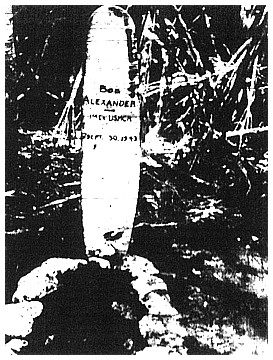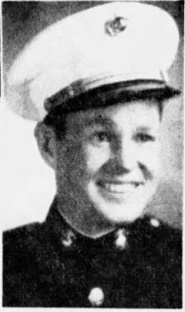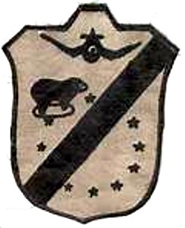Davenporter Downs a Zero
Only to Be Rescued by a
Davenporter in South Pacific
Altho he has been on combat duty only a week weeks, Lieut. Robert A. Alexander, United States marine corps, son of Mr. and Mrs. Robert Alexander, 229 Hillcrest avenue, has shot down a Jap Zero and had his own personal plane badly crippled by four other Zeros that he was forced to make a crash landing on an island somewhere in the South Pacific.
Coincident with the crash is the fact that the island on which he landed was occupied by Seabees and he was pulled from the wreckage of the plane by a fellow Davenporter, Way Cox, son of Mrs. Elma Cox, 712 East Fourteenth street, in charge of the Seabee group.
In a letter to his parents, he told of the experience in shooting down the Zero. “It was the biggest thrill of my life,” he said. A few days later his plane was attacked in a combat area by four Zeroes and seriously damaged. He managed to fly the ship to the nearest island, 70 miles away, where he crash landed.
“We go to work at 4 p. m. and don’t get back to our station until 8 p. m.,” Lieut. Alexander wrote. “We never see our quarters in the daylight and during the night we have to be constantly on the alert for radar attacks.”
Lieut. Alexander was elected governor of the Hawkeye Boys’ State at Camp Dodge in 1939 while he was attending Davenport high school.
He entered the service April 23, 1942 and was sent to the south seas last June.
Source: Davenport Democrat and Leader, Davenport, Iowa, Tuesday, October 7, 1943
![]()
On September 30th, 1943, Lt. Alexander took off from Munda Air Field with three other Corsairs on a patrol flight. Due to oxygen failure, one of the planes was forced to return to base. The other 3 continued on their patrol. Near Kolombangara Island three ships were discovered and the pilots flew down to investigate the situation. The ships were recognized as friendly PT-boats, one of them shooting recognition fire. Consequently, Lt. Alexander accidentally fired at the PT-boats, hitting the stern of one of the boats. The PT-boats returned fire, causing Lt. Alexander’s Corsair to crash into the jungle near Ropa Point of the island. The plane exploded into a fireball.
Major Gregory “Pappy” Boyington, VMF-214 pilots Frank Walton and Doc Reames, among others, used a PT- boat to search for Lt. Alexander’s remains on December 5, 1943. They found the crashed plane and Lt. Alexander’s remains. They buried him on Kolombangra Island, using a blade of the plane’s propeller as a headstone.
Sources:
Sherman, Stephen. “VMF-214: Marine Fighting Squadron in WWII.” July 1, 2001. acepilots.com/usmc_vmf214.html
Pacificwrecks.com/aircraft/f4u/alexender.html
![]()
GRAVE

The propeller blade of his demolished fighter plane marks the burial ground of First Lieut. Robert A. Alexander, 22, son of Mr. and Mrs. Robert Alexander, 229 Hillcrest avenue, Davenport, on the shore of Kolombangara Island where his plane crashed Sept. 30, 1943. Lieut. Alexander, marine corps flier, was a member of Boyington’s Black Sheep squadron, commanded by Maj. Gregory Boyington, now listed as missing in action. The Davenport pilot, who enlisted in the marine cops April 13, 1942, went to the South Pacific in June, 1943. (AP photo from marine corps.)
Source: Davenport Democrat and Leader, Davenport, Iowa, Thursday, January 27, 1944
![]()
TRAVEL 50 MILES BY PT BOAT
to BURY COMRADE in JUNGLES
(The following story was written by Sgt. Dan Bailey, Atlanta, Ga., a marine corps combat correspondent, and is distributed by the Associated Press.)
VELLA LAVELLA – (Delayed) – In a tropical rain storm, the remains of a marine fighter pilot were buried today on a lonely shore of Kolombangara island, where his plane crashed Sept. 30. Members of his squadron traveled 50 miles by PT boat to conduct the ceremony.
The airman was 1st Lt. Robert A. Alexander, 22, of Davenport, Ia. He was a member of “Boyington’s Black Sheep” squadron, commanded by Maj. Gregory Boyington of Okanagon, Wash., a former “Flying Tiger,” who is now listed as missing in action after shooting down 26 Jap planes.
No previous attempt had been made to find Lt. Alexander, because the island is in Jap hands until recently. 1st Lt. Burney L. Tucker, of Murfreesboro, Tenn., was flying near Lt. Alexander when he crashed, led the group to the scene near Ropa point, northeast Kolombangara.
As one of the group told the story: “We went ashore in rubber boats. It was not hard to find the plane. In crashing, it had cut a path through the palm trees 50 feet wide and nearly 100 feet long. It was demolished, but had not burned. We found Alexander.”
The officers brought rocks and coral up from the beach and made a protective mound for the grave. For a headstone, they used a propeller blade with the flyer’s name scratched on it.
Members of the group were: Maj. Boyington; Lt. James M. Reames, 26, Hughes, Ark., flight surgeon; 1st Lt. Frank E. Walton, 34, Los Angeles; 1st Lt. Paul A. Mullen, 23, Pittsburgh, Pa., pilot; and, 1st Lt. Robert W. McClurg, 24, New Castle, Pa., pilot.
Source: The Council Bluffs Nonpareil, Council Bluffs, Iowa, Thursday, January 27, 1944
![]()
Robert Austin Alexander was born Jan. 24, 1921 to Robert A. and Johanna Alexander. He died Sept. 30, 1943 and is buried in Memorial Park Cemetery, Davenport, IA. He was initially buried on Kolombangara in the Solomon Islands.
Source: ancestry.com
![]()


